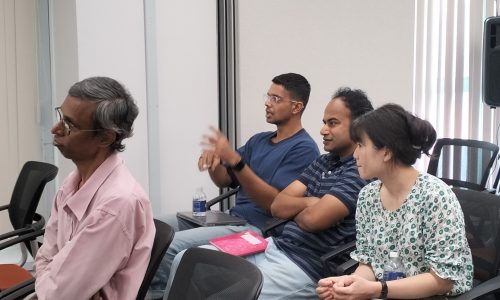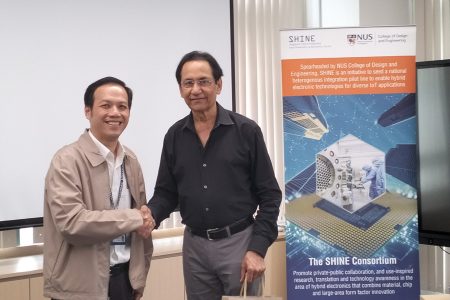Fault Location In Circuitry Using Magnetic Field
June 28, 2023
Overseas Speaker Talk Series – Post Event Report
Fault Location In Circuits Using Magnetic Field Imaging
Date: 28 June 2023, Wednesday
Time: 10.30 to 11.30 am
Venue: Block E6, #06-02, 5 Engineering Drive 1, Singapore 117608
On June 28, we had the privilege of hosting Professor Venkatesan (aka Prof Venky), Director of the Center for Quantum Research and Technology at the University of Oklahoma, as the overseas speaker for a talk titled “Locating the Coordinates of Faults in Electrical Circuitry.” The event took place at the campus of College of Design and Engineering and aimed to explore the importance of identifying faults in various electrical circuitry and the utilization of magnetic fields and x-rays for fault analysis.
Key Discussion Points:
Increasing Yields and Advancing Next-Generation Electronic Technology:
Prof Venky emphasized the crucial role of fault analysis in improving yields and advancing electronic technology. He highlighted the significance of accurately locating faults to identify areas for improvement and optimize the manufacturing process. The discussion shed light on the importance of addressing faults promptly to minimize production delays and reduce costs.
The Unique Properties of Magnetic Fields and X-rays:
Prof Venky discussed the unique characteristics of magnetic fields and x-rays as enabling media for fault analysis. He emphasized that these modalities are not easily absorbed by the materials used in circuitry fabrication, making them suitable for non-destructive fault analysis. This insight highlighted the potential of magnetic field and x-ray imaging techniques in fault analysis processes.
Pressing Need for 3D Defect Localization:
The rapid growth of advanced packaging techniques has created a pressing need for the localization of defects in three dimensions. Traditional fault analysis techniques relying on photons, electrons, heat, and sound are gradually being replaced by magnetic field and x-ray imaging methods. Attendees gained valuable insights into the challenges associated with fault analysis in three-dimensional structures and how magnetic field and x-ray imaging offer promising solutions.
Complementary Nature of Magnetic Field and X-ray Imaging:
Prof Venky emphasized the complementary nature of magnetic field and x-ray imaging techniques. He explained that while x-rays primarily detect density differences, magnetic field imaging directly captures electrical characteristics, providing valuable additional information. The combination of these two modalities enhances fault analysis capabilities and enables more accurate defect localization.
Neocera Magma – The Magnetic Field Imaging System:
During the talk, Prof Venky introduced MAGMA, the magnetic field imaging system from Neocera. He shared details about the system, which utilizes two quantum sensors: a superconducting quantum interference device (SQUID) and a giant magneto-resistive sensor (GMR). He discussed the operation, advantages, limitations, and possible future roadmap for the MAGMA system, providing the attendees with valuable insights into the practical implementation of magnetic field imaging techniques.
Question and Answer Session:

The talk included an engaging question and answer session where attendees actively participated. Prof Venky addressed various queries related to the magnetic field and x-ray imaging techniques, associated equipment and technologies, and the potential applications of AI in their adoption. The interactive session allowed for a deeper understanding of the topics discussed and provided valuable clarification for the attendees.
Token of Appreciation:

At the end of the talk, Professor Lim Yeow Kheng, the Programme Director of the SHINE Centre, presented Prof Venky with a token of appreciation. The gesture recognized Prof Venky’s valuable insights into emerging technologies for fault analysis in 3D structures.
About the Speaker

Prof. T. Venkatesan is a distinguished academic and researcher with an impressive background. He currently serves as the Director of the Center for Quantum Research and Technology at the University of Oklahoma and is affiliated with NIST Gaithersburg. Prof. Venkatesan is also the founding Director of the Center of Optimal Materials for Emerging Technologies at the University of Oklahoma. Previously, he held positions such as Director of the Nano Institute at the National University of Singapore and various roles at Bell Labs and Bellcore.
Prof. Venkatesan is renowned for his contributions as the inventor of the pulsed laser deposition (PLD) process and has an extensive publication record of over 800 papers and 34 patents. He is highly regarded in the scientific community and is recognized as one of the top physicists globally, ranked 66th in 2000 based on citations. He has mentored numerous students, having supervised over 56 PhDs, 35 Post Docs, and over 35 undergraduates.
In addition to his academic pursuits, Prof. Venkatesan is actively involved in entrepreneurship. He is the founder and Chairman of Neocera and Neocera Magma, companies specializing in PLD and magnetic field imaging systems. He is also a co-founder of Blue Wave Semiconductors. Prof. Venkatesan has played a key role in launching healthcare companies in Singapore, namely Cellivate and Breathonix, and many of his students have become entrepreneurs, establishing over 25 different commercial enterprises.
Prof. Venkatesan holds prestigious fellowships and memberships in various organizations, including the Royal Society, National Academy of Inventors, Singapore National Academy of Science, and Asia-Pacific Artificial Intelligence Academy, among others. He has received numerous awards and honors throughout his career, including the Bellcore Award of Excellence, George E. Pake Prize, and Distinguished Lectureship on the Applications of Physics Award from the American Physical Society. He is also actively involved in professional committees and has served as a Guest Professor at Tsinghua University and held positions in APS and UMD committees. He has been recognized with outstanding alumnus awards from Indian Institute of Technologies in Kanpur and Kharagpur, India.
- Home
- Fault Location In Circuitry Using Magnetic Field
Singapore Hybrid-Integrated Next-Generation μ-Electronics (SHINE) Centre
- Block E6, #E6-5-3, 5 Engineering Drive 1, Singapore 117608
- +65 6601 8522
- shine@nus.edu.sg

